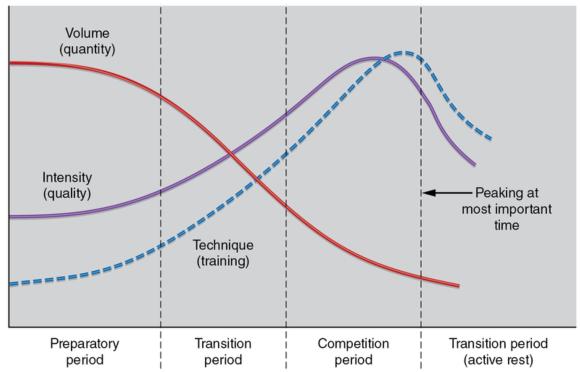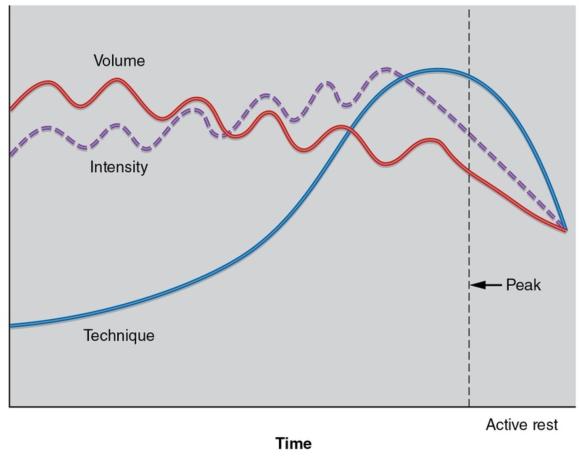Periodisation
This is an excerpt from EuropeActive's Essentials for Personal Trainers by .
The roots of periodisation come from Hans Selye's model, known as the general adaptation syndrome, which has been used by the athletic community since the late 1950s (Selye 1950). Selye identified a source of biological stress referred to as eustress, which denotes beneficial muscular strength and growth, as well as a distress state, which is stress that can lead to tissue damage, disease and death.
The principle of periodisation refers to the systematic process of changing one or more programme variables over time to allow the training stimulus to stay demanding and efficient (Ratamess et al. 2009). Periodisation can involve, for example, systematically alternating high loads of training with decreased loading phases to improve components of muscular fitness (e.g., maximal strength, hypertrophy and muscular endurance). Personal trainers recommend various periodisation programmes for the continuing development of their clients. Periodisation protocols are thought to optimise the continuing development of physical performance for the following reasons: Cumulative fatigue is dispersed, thereby reducing the risk for overtraining; the varying training stimuli associated with periodisation yield greater and faster gains than training at the constant intensity; and the programme remains interesting and challenging for the client, thereby improving long-term commitment.
Periodisation programmes for athletes are typically divided into three cycles of different duration: microcycle, mesocycle and macrocycle. The microcycle generally lasts up to 7 days. The mesocycle may last anywhere from 2 weeks to a few months. It can be further classified into preparation, competition, peaking and transition phases. The macrocycle refers to the overall training period, usually representing a year. It is useful to shorten this period down to 3 months, which seems to be a more realistic time frame for the client. It moreover facilitates promotion and marketing activities.
Numerous research studies have investigated physiological effects of different training volumes (total repetitions per workout) and intensities. Most research studies have demonstrated superior changes in muscle mass, strength, muscular endurance and performance of periodised over non-periodised programmes. Even over a short period of time (weeks to months), systematic variation in training volume and intensity results in greater gains compared with non-periodised programs using constant sets and repetitions (e.g., 4 sets of 10 repetitions; Fleck and Kraemer 2014; Ratamess et al. 2009).
As stated previously volume and intensity are important components of periodisation. However numerous other variables should be considered for optimal periodisation for each client: choice of exercises, order of exercises, number of muscle groups per training session, number of sets per exercise, number of exercises per muscle group, repetition range, speed of lifting and lowering the weight, rest period between sets and rest days between training the same muscle groups again.
Linear and undulating periodisation are two common systems of planned variation (see figures 15.1 and 15.2). In the linear model a training cycle begins with a high-volume, low-intensity programme, then progresses to a low-volume, high-intensity one over the coming months. Thus the linear model typically describes a progression from high-volume and low-intensity work towards decreasing volume and increasing intensity during the different cycles. A variant of linear periodisation is the stepwise periodisation in which intensity increases and volume decreases during the training period, but volume is decreased in a stepwise fashion (e.g., repetitions are reduced from 10 to 8, 8 to 5, 5 to 2 and so on at specific time intervals; Kraemer and Fleck 2007).

The model of linear periodisation.
Reprinted, by permission, from NSCA, 2008, Periodization, by D. Wathen et al. Essentials of strength training and conditioning, 3rd ed., edited by T.R. Baechle and R.W. Earle (Champaign, IL: Human Kinetics), 50.
In undulating periodisation training volume and intensity increase and decrease on a regular basis rather than following the linear pattern. Intensity and volume are typically shifted up and down on a weekly basis. This type of periodised loading is thought to optimise strength gains by regularly inducing training stimuli and to favour both muscle growth (high-volume training) and neural adaptations (high-intensity training).

The model of undulating periodisation.
Reprinted, by permission, from NSCA, 2008, Periodization, by D. Wathen et al. Essentials of strength training and conditioning, 3rd ed., edited by T.R. Baechle and R.W. Earle (Champaign, IL: Human Kinetics), 50.
Numerous periodisation programmes exist. Two popular and effective programmes are hypertrophy-specific training (HST) and Smolov Jr. training.
SHOP

Get the latest insights with regular newsletters, plus periodic product information and special insider offers.
JOIN NOW


